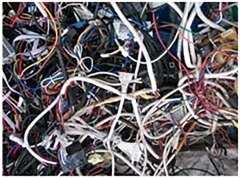

Nov . 20, 2024 18:25 Back to list
Understanding Scrap Iron Shredders The Backbone of Metal Recycling
In today's world, the importance of recycling cannot be overstated, particularly when it comes to metals. The ever-increasing demand for raw materials and the need for sustainable practices have made the recycling industry more crucial than ever. Among the various processes involved in metal recycling, the role of scrap iron shredders stands out, serving as a vital piece of equipment in transforming discarded iron and steel into reusable resources.
Scrap iron shredders are heavy-duty machines designed to efficiently break down large scrap metal into smaller, manageable pieces. These machines operate using powerful, high-speed blades that shred the metal into fragments, which can then be further processed or melted down for reuse. The shredding process not only speeds up the recycling operation but also improves the quality of the end product by reducing contaminants and enhancing material uniformity.
One of the primary advantages of using a scrap iron shredder is the efficiency it brings to the recycling process. Traditional methods of metal recycling often involve manual labor, which can be time-consuming and labor-intensive. In contrast, shredders automate this process, allowing for a higher throughput of material. This automation significantly reduces the time and labor costs associated with recycling metal, making it a more attractive option for businesses looking to optimize their operations.

Moreover, scrap iron shredders promote environmental sustainability. By facilitating the recycling of metal, these machines play a key role in conserving natural resources and reducing the need for new raw materials. The extraction and processing of virgin metals are energy-intensive and environmentally damaging activities. By recycling scrap iron, businesses can contribute to a circular economy, where materials are repurposed and reused rather than discarded. This process not only helps in reducing landfill waste but also minimizes the carbon footprint associated with metal production.
Another notable feature of modern scrap iron shredders is their advanced technology, which includes sensors and automation systems that enhance their operational capabilities. These advancements allow shredders to handle a variety of scrap materials, including iron, steel, and even non-ferrous metals. They are designed to process materials of varying sizes and compositions, making them versatile for different types of recycling operations.
Safety is another critical aspect of using scrap iron shredders. Modern models are equipped with safety features such as emergency stop systems and automatic shut-off mechanisms that help protect operators during the shredding process. These considerations are essential, as the machinery operates at high speeds and can be dangerous if not handled correctly.
In conclusion, scrap iron shredders are indispensable tools in the recycling industry, providing efficiency, safety, and environmental benefits. As the world continues to grapple with resource scarcity and environmental sustainability, the role of shredders will only grow in importance. By investing in advanced shredding technology, businesses can not only enhance their operational efficiency but also contribute positively to the planet. The future lies in recycling, and scrap iron shredders are leading the way.
Latest news
Troubleshooting Common Eddy Separator Problems
NewsJul.04,2025
The Role of Metal Recycling Plants in Circular Economy
NewsJul.04,2025
The Impact of Recycling Line Pickers on Waste Management Costs
NewsJul.04,2025
Safety Features Every Metal Shredder Should Have
NewsJul.04,2025
How Industrial Shredders Improve Waste Management Systems
NewsJul.04,2025
How Cable Granulators Contribute to Sustainable Recycling
NewsJul.04,2025